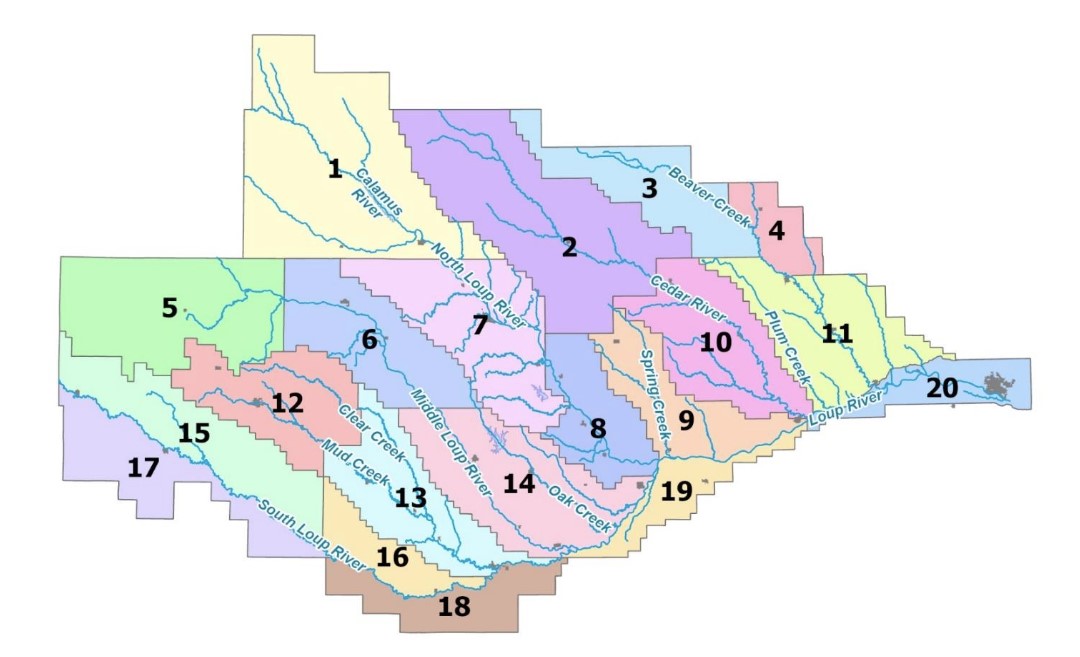Recent rains have brought relief to some parts of Nebraska, but unfortunately, much of the Lower Loup NRD remains very dry.
Even during times of adequate precipitation, we know that drought will someday come. Instead of waiting for drought and then scrambling to deal with it, in 2021, the Lower Loup NRD (LLNRD) began developing a Drought Management Plan. Groundwater and surface water irrigators, ranchers, city administrators, hydropower industry representatives, LLNRD staff and directors, and other stakeholders joined for a series of meetings centered around a mock drought scenario based on actual recent conditions.
Every drought event is different with varying impacts. Identifying and responding effectively to drought is technically and politically challenging. A pre-established plan, developed before drought occurs, can help ease these pressures and enable decision makers to respond in an informed and transparent way.
Conservation, regulation, and the creation of drought zones were among the topics discussed. Participants shared how those actions, and the activities of neighbors, could impact their own operations. This Drought Advisory Group also discussed possible drought response protocol.
The plan was developed to be a guide to the Lower Loup NRD Board of Directors to enhance drought response. Our Board of Directors approved the plan in September 2022.
Less than a year later, and according to the plan’s guidelines, drought conditions rated as “Extreme” have triggered a response. The Lower Loup NRD’s Water Resources Committee looked at the situation during its July 2023 meeting, ultimately recommending to the full board to initiate the process to require flow meters on all irrigation systems in Drought Zones 18 (northern Buffalo and extreme northwest Hall counties) and 20 (parts of southern Nance and Platte counties, and northeast Butler County). The Board of Directors voted at its July 2023 meeting to begin that process.
That process includes a yet to be scheduled public hearing. If approved, irrigators would have two years to install flow meters on all irrigation systems in Drought Zones 18 and 20.
Why now?
In accordance with the laws of the State of Nebraska, among other purposes and responsibilities, Nebraska’s NRDs are tasked with the conservation of surface water and groundwater. In other words, we must act. Here’s why:
LLNRD technicians measure wells across the district every year. Since data collection began in 1982, static water levels in parts of Drought Area 18 have dropped nearly 19 feet. Over the same period in Drought Area 20, static water level readings indicate wells dropping as much as 12 feet. Much of this drop has happened over the last 10 years. Prolonged drought and increased demand for surface water and groundwater have fueled these declines.
A response is required according to the Lower Loup NRD’s Drought Management Plan if two of the following have been triggered:
• A) Regional Short-Term Drought Status is rated at D3, (Extreme) intensity or higher (D4) across greater than 50% of a Drought Zone.
• B) Local Long-term Groundwater Status: If more than half of readings are consistently at or below the lowest ever recorded, then additional management is required in that Drought Zone.
• C) Local Surface Water Status: Streamflows are at the lowest of the site’s full historical range measured for that time of year.
• D) Local Reporting of Drought Impacts: Reports of well impacts throughout an area.
• E) Regional Drought Forecasting: Situational. Consult Drought Stakeholders and LLNRD Board.
If the flow meter requirement is enacted, fields without flow meters will require flow meter installation within the next two years. Additional restrictions, if required, will be determined by the Lower Loup NRD Board of Directors.
View the 2023 LLNRD Static Water Level Report and the 2022 LLNRD Drought Management Plan
Drought Zones are shown below:
